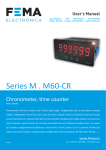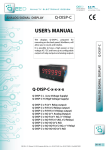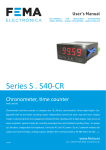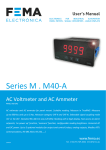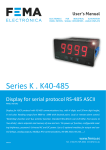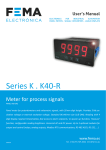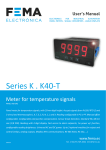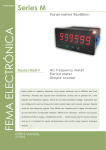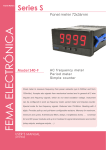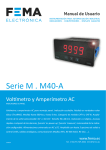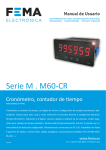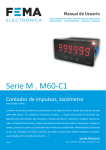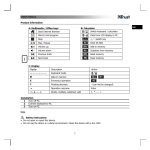Download User`s Manual - M60-C1
Transcript
User’s Manual ELECTRONICS FOR INDUSTRIAL AUTOMATION PANEL METERS . SIGNAL CONVERTERS . LARGE DISPLAYS Series M . M60-C1 Impulse counter, ratemeter PANEL meters Impulse counter, ratemeter and periodmeter, with 14 mm digit height. Accepts all type of impulse sensors (NPN, PNP, Namur, TTL, inductive, mechanical, encoders, ...). Provides configurable excitation voltage to power-up the transducer. Standard 96 x 48 mm size (1/8 DIN). Reading with 6 digit display. Fast access to alarm setpoints, special modes for fast counting and for slow ratemeter applications, ‘on power up’ function, configurable reading brightness. Universal AC and DC power. Up to 3 optional modules for output and control (relays, analog outputs, Modbus RTU communications, RS-485 ASCII, RS-232, ...) 2975r10 www.fema.es Tel. (+34) 93.729.6004 [email protected] FEMA ELECTRÓNICA . Series M . M60-C1 1. Panel meter M60-C1 Counter, ratemeter and periodmeter, 96 x 48 mm (1/8 DIN) Panel meter 96 x 48 mm (1/8 DIN) and 6 digits with 14 mm digit height, configurable with 5 impulse counter modes (see section 1.2), 2 ratemeter modes (see section 1.3) and a 1 periodmeter mode (see section 1.4). Highly configurable, accepts all types of sensors (NPN, PNP, pushpull, Namur, inductive, pick-up, mechanical, TTL, CMOS, ...) including quadrature signals (single and bidirectional encoder signals). Reading from 999999 to -199999 with decimal point, scalable reading with configurable multiplier factor (1 to 999999) and configurable divider factor (1 to 999999). Includes internal pull-up and pull-down resistors, configurable trigger levels, detection by rising or falling edge, excitation voltage configurable from 5 Vdc to 18 Vdc. Options for output and control with 1, 2 and 3 relays, isolated analog outputs, communications in Modbus RTU, RS-485 ASCII and RS-232. Special options with 4 and 6 relay outputs. Independent alarms configurable as maximum or minimum, with 1 or 2 setpoints per alarm, hysteresis, independent activation and deactivation delays and control for inverted relay. Front protection IP54 with optional IP65. Connections by plug-in screw terminals. For industrial applications. • ‘Fast access’ menu to selected functions, accessible with key UP (5) (see section 1.19.12) • Function ‘On power up’ for system protection on first ‘cold’ startup or automatic reset (see section 1.19.14) • Special ‘FAST’ mode for fast counting applications (see section 1.16) • Special ‘SLOW’ mode for slow ratemeter applications (low frequency applications) (see section 1.15) • Direct configuration for most usual sensor, at the ‘SnSr / Auto’ menu (see section 1.19.10) • Function ‘Trigger Sense’ helps to detect the correct trigger level (see section 1.13) Multiple display filters, memory for maximum and minimum reading, password protection, 5 brightness levels. Index 1. Panel meter M60-C1 . . . . . . . . . . . . . . . . . . . . . . 2 1.1 How to order . . . . . . . . . . . . . . . . . . . . . . . . . 3 1.2 Impulse counter modes . . . . . . . . . . . . . . . . . . . 3 1.3 Ratemeter modes . . . . . . . . . . . . . . . . . . . . . . 3 1.4 Periodmeter mode . . . . . . . . . . . . . . . . . . . . . 3 1.5 Functions included . . . . . . . . . . . . . . . . . . . . . 3 1.6 Front view . . . . . . . . . . . . . . . . . . . . . . . . . . 4 1.7 Power connections . . . . . . . . . . . . . . . . . . . . . 4 1.8 Sensor configuration and connections . . . . . . . . . . . 4 1.9 Rear view . . . . . . . . . . . . . . . . . . . . . . . . . . . 4 1.10 Signal connections . . . . . . . . . . . . . . . . . . . . . 4 1.11 Technical specifications . . . . . . . . . . . . . . . . . . 5 1.12 Mechanical dimensions (mm) . . . . . . . . . . . . . . 5 1.13 Function ‘Trigger Sense’ . . . . . . . . . . . . . . . . . . 6 1.14 Function ‘cycle counter’ . . . . . . . . . . . . . . . . . . 6 1.15 ‘SLOW’ mode . . . . . . . . . . . . . . . . . . . . . . . . 6 1.16 ‘FAST’ mode . . . . . . . . . . . . . . . . . . . . . . . . 6 1.17 How to operate the menus . . . . . . . . . . . . . . . . 7 1.18 Messages and errors . . . . . . . . . . . . . . . . . . . . 7 1.19 Configuration menu . . . . . . . . . . . . . . . . . . . . 8 1.19.1 Initial set-up . . . . . . . . . . . . . . . . . . . . . . 8 1.19.2 Configuration for ‘cn.1’ . . . . . . . . . . . . . . . . 8 1.19.3 Configuration for ‘cnq.2’ . . . . . . . . . . . . . . . . 9 1.19.4 Configuration for ‘cnI.3’ . . . . . . . . . . . . . . . . 9 1.19.5 Configuration for ‘cnc.4’ . . . . . . . . . . . . . . . . 9 1.19.6 Configuration for ‘cnd.5’ . . . . . . . . . . . . . . . 10 1.19.7 Configuration for ‘rt.6’ . . . . . . . . . . . . . . . . 10 1.19.8 Configuration for ‘rtq.7’ . . . . . . . . . . . . . . . 10 1.19.9 Configuration for ‘Prd.8’ . . . . . . . . . . . . . . . 11 1.19.10 Sensor configuration . . . . . . . . . . . . . . . . 11 1.19.11 Alarms . . . . . . . . . . . . . . . . . . . . . . . . 13 1.19.12 Fast access . . . . . . . . . . . . . . . . . . . . . . 14 1.19.13 Super fast access . . . . . . . . . . . . . . . . . . 14 1.19.14 Menu ‘On Power Up’ . . . . . . . . . . . . . . . . 14 2 1.19.15 Menu ‘Key LE’ . . . . . . . . . . . . . . . . . . . . 15 1.19.16 Menus ‘Overrange / underrange’ . . . . . . . . . 15 1.19.17 Left zeros . . . . . . . . . . . . . . . . . . . . . . 15 1.19.18 Function ‘Password’ . . . . . . . . . . . . . . . . 15 1.19.19 Factory reset . . . . . . . . . . . . . . . . . . . . 15 1.19.20 Firmware version . . . . . . . . . . . . . . . . . . 15 1.19.21 Brightness . . . . . . . . . . . . . . . . . . . . . . 15 1.19.22 Access to optional modules . . . . . . . . . . . . 15 1.20 Full configuration menu . . . . . . . . . . . . . . . . . 16 1.21 Factory configuration . . . . . . . . . . . . . . . . . . 19 1.22 To access the instrument . . . . . . . . . . . . . . . . 20 1.23 Modular system . . . . . . . . . . . . . . . . . . . . . 20 1.24 Precautions on installation . . . . . . . . . . . . . . . 21 1.25 Warranty . . . . . . . . . . . . . . . . . . . . . . . . . 21 1.26 CE declaration of conformity . . . . . . . . . . . . . . 21 2. Output and control modules . . . . . . . . . . . . . . . . . 22 2.1 Module R1 . . . . . . . . . . . . . . . . . . . . . . . . . 22 2.2 Module AO . . . . . . . . . . . . . . . . . . . . . . . . . 22 2.3 Module RTU . . . . . . . . . . . . . . . . . . . . . . . . 23 2.4 Module S4 . . . . . . . . . . . . . . . . . . . . . . . . . 23 2.5 Module S2 . . . . . . . . . . . . . . . . . . . . . . . . . 24 2.6 Modules R2, R4, R6 . . . . . . . . . . . . . . . . . . . . 24 3. Other options . . . . . . . . . . . . . . . . . . . . . . . . . 26 3.1 Option NBT . . . . . . . . . . . . . . . . . . . . . . . . . 26 3.2 Option 65 . . . . . . . . . . . . . . . . . . . . . . . . . 26 3.3 Option G . . . . . . . . . . . . . . . . . . . . . . . . . . 26 4. Accessories . . . . . . . . . . . . . . . . . . . . . . . . . . 27 4.1 THM benchtop housing . . . . . . . . . . . . . . . . . . 27 4.2 Adapter DRA-M . . . . . . . . . . . . . . . . . . . . . . 27 4.3 Adapter KA96 . . . . . . . . . . . . . . . . . . . . . . . 27 4.4 WME housing . . . . . . . . . . . . . . . . . . . . . . . 27 4.5 Protector KIP . . . . . . . . . . . . . . . . . . . . . . . . 27 FEMA ELECTRÓNICA . Series M . M60-C1 1.1 How to order Model M60 - C1 Power - H -H -L (85-265 Vac/dc) (11/60 Vdc, 24 Vac, 48 Vac) Option 1 Option 2 - -R1 -AO -RTU -S4 -S2 - Option 3 - Others -NBT -65 -G (1 relay) (analog output) (Modbus RTU) (RS-485) (RS-232) (empty) 1.2 Impulse counter modes The instrument allows for 5 selectable impulse counter modes : • Counter (‘cn.1’) (see section 1.19.2) • Counter quadrature (‘cnq.2’) (see section 1.19.3) • Counter with inhibition (‘cnI.3’) (see section 1.19.4) • Counter with control add / substract (‘cnc.4’) (see section 1.19.5) • Counter differential (‘cnd.5’) (see section 1.19.6) Configurable up or down counting, ‘reset’ at rear terminals, front key and/or at alarm activation. Configurable ‘Preset’ value. Relay activation and deactivation delays. Alarm functions with ‘return to preset’ or ‘reset to 0’ generate cycles of counting (instrument counts from ‘preset’ value to alarm value in never ending cycle). The instrument provides memory of cycles counter. Scalable reading with configurable multiplier factor (1 to 999999) and configurable divider factor (1 to 999999). Memory retention in case or power loss. Retains configuration and last reading. Counting frequency up to 250 KHz, in ‘FAST’ mode (see section 1.16). (no buttons) (front IP65) (green led) 1.5 Functions included Functions included Section ‘Fast access’ yes ‘SLOW’ mode yes, for slow frequencies 1.15 ‘FAST’ mode yes, for fast counting 1.16 Multiplier and divider from 1 to 999999 Reset configurable yes (front, rear and linked to alarm activation) Preset yes 1.19.2 Trigger level configurable 1.19.10 ‘Trigger Sense’ function helps to set the trigger Sensor selection by menu Cycle counter 1.19.12 1.19.2 1.19.15 and 1.10 and 1.19.11 1.13 1.19.10 1.14 1.3 Ratemeter modes Retention memory yes, recovers with power In ratemeter mode the reading is proportional to the measured frequency. The instrument allows for 2 selectable ratemeter modes : • Ratemeter (‘rt.6’) (see section 1.19.7) • Ratemeter quadrature (‘rtq.7’) (see section 1.19.8) The ratemeter mode has a single input channel, with scalable reading. The quadrature ratemeter mode has 2 inpur channels available for detection of sense of turn when working with quadrature signals. Scalable reading with configurable multiplier factor (1 to 999999) and configurable divider factor (1 to 999999). For low frequency applications, the ‘SLOW’ mode provides the best response time for each application (see section 1.15). Maximum frequency up to 900 KHz and minimum frequency down to de 0.001 Hz (1 mHz) with ‘SLOW’ mode active. ‘On Power Up’ yes 1.19.14 Excitation voltage configurable 1.19.10 Display filters recursive Memory max., min., cycles 1.19.12 Password blocks access to configuration menu 1.19.18 Alarms double setpoints activation delays deactivation delays hysteresis inverted relays locked alarms 1.19.11 Display brightness 5 levels 1.19.21 1.4 Periodmeter mode Reading is proportional to the signal period. Scalable reading with configurable multiplier factor (1 to 999999) and configurable divider factor (1 to 999999). For applications with long periods (slow frequencies), the ‘SLOW’ mode provides the best response time for each application (see section 1.15). 1.11 1.19.7 and 1.19.8 and 1.19.9 Table 1 - Functions included 3 FEMA ELECTRÓNICA . Series M . M60-C1 1.6 Front view 1.9 Rear view Option 3 Alarms Logo Units Units Button ‘LE’ Button ‘UP’ Button ‘SQ’ Front reset (see section 1.19.15) ‘Fast access‘ (see section 1.19.12) ‘Configuration menu’ (see section 1.19) Option 2 1 2 3 4 5 8 9 0 Signal (see section 3.2) Power (see section 1.7) Detail of the plug-in screw terminals provided with the instrument. The instrument is provided with all terminals needed, both male and female. 1.7 Power connections Earth connection - Although a terminal is provided for earth connection, this connection is optional. The instrument does not need earth connection for correct operation nor for compliance with the security regulations. Option 1 890 1.10 Signal connections ~ + ~ - 1 2 3 4 5 Reset Fuse - To comply with security regulation 61010-1, add to the power line a protection fuse acting as disconnection element, easily accessible to the operator and identified as a protection device. Power ‘H’ fuse 250 mA time lag Power ‘L’ fuse 400 mA time lag Canal B Canal A Vexc. 0 V 1.8 Sensor configuration and connections Selecting one of the sensors listed at the ‘SnSr’ menu entry, will configure the sensor parameters to the values indicated in the table. Sensor Connections Pulls Vexc. Antirrebound filter Trigger 100 mSec. 2,5 Vdc 9 Vdc no 3,0 Vdc Mechanical contact 0 V channel A pull-up The table also indicates the typical connections for each type of sensor. Parameters can be manually modified. Namur pull-down NPN 2 wires 0 V channel A pull-up 18 Vdc no 2,5 Vdc Connections are indicated for a single sensor connected to the channel A. For two sensors (for inhibition control, quadrature signal, etc) apply the same connection criteria also to channel B. NPN 3 wires 0 V channel A Vexc pull-up 18 Vdc no 2,5 Vdc PNP 2 wires 0 V channel A pull-down 18 Vdc no 2,5 Vdc PNP 3 wires 0 V channel A Vexc pull-down 18 Vdc no 2,5 Vdc Push-pull 0 V channel A Vexc no 18 Vdc no 2,5 Vdc TTL CMOS Pick-up 0 V channel A no 5 Vdc no 2,5 Vdc AC<30 Vp Inductive 0 V channel A no no no 0 Vdc Note : indicated values are typical values. Check the correct specifications with your sensor datasheet and adapt the required configuration and connections as needed. channel A Vexc Table 2 - Configuration and connections for different types of sensors. 4 no FEMA ELECTRÓNICA . Series M . M60-C1 1.11 Technical specifications Digits number of digits led color digit height 6 7 segments led red or green 14 mm Reading maximum reading minimum reading decimal point 999999 -199999 configurable X.X.X.X.X.X. overrange / underrange display refresh configurable to flash, reset or preset (see section 1.19.16) 15 readings / second memory retention yes, retains reading value in case of power loss Signals accepted Max. Vdc at input Input impedance NPN, PNP, Namur, pick-up, TTL, inductive, mechanical, quadrature, ... ±30 Vdc 2K4 with pull-up or pull-down resistor 470K without pull resistor Accuracy of the quartz Thermal drift ±0.01 % 20 ppm / ºC Excitation voltage output voltage maximum current protection configurable +18 Vdc, +15 Vdc, +9 Vdc, +5 Vdc 70 mA yes, current limited to 70 mA Frequencies counter modes (see Table 3) ratemeter modes (see Table 4) periodmeter modes (see Table 5) Power power ‘H’ power ‘L’ isolation* consumption 85 to 265 Vac/dc 11 to 60 Vdc and 24/48 Vac 2500 Veff with power ‘H’ 1500 Veff with power ‘L’ *tested for 60 sec. <1.5 W only meter <4.0 W meter with options Configuration 3 buttons front keypad Front protection IP54 standard IP65 optional (see section 3.2) Frequency Section ‘FAST’ mode active max. 250 KHz 1.19.2 normal mode max. 9 KHz 1.19.2 Counter + inhibition max. 9 KHz 1.19.4 Counter + control A/S max. 9 KHz 1.19.5 Counter differential max. 9 KHz 1.19.6 mode x1 max. 17 KHz 1.19.3 mode x2 max. 16 KHz 1.19.3 mode x4 max. 11 KHz 1.19.3 Counter Counter quadrature Mode Table 3 - Maximum input frequency for counter modes Ratemeter Ratemeter Ratemeter quadrature Mode Frequency Section normal mode max. 900 KHz 1.19.7 ‘SLOW’ mode active max. 200 KHz min. 1 mHz 1.19.7 mode x1 max. 17 KHz 1.19.8 mode x2 max. 16 KHz 1.19.8 mode x4 max. 11 KHz 1.19.8 Table 4 - Maximum and minimum input frequency for ratemeter modes Periodmeter Output and control options relays, analog outputs, serial communications (see section 2) Mechanical mounting panel connections plug-in screw terminal housing material ABS, polycarbonate (V0) weight <150 grams front size 96 x 48 mm (1/8 DIN) panel cut-out 92 x 44 mm depth from panel 91 mm (including terminals) Temperature operation storage warm-up time Counter from 0 to +50 ºC from -20 to +70 ºC 15 minutes Periodmeter Mode Frequency Section normal mode max. 900 KHz 1.19.9 ‘SLOW’ mode active max. 200 KHz min. 1 mHz (1000 sec.) 1.19.9 Table 5 - Maximum and minimum input frequency for periodmeter modes 1.12 Mechanical dimensions (mm) 48 96 16 44 75 8 Panel cut-out 92 5 FEMA ELECTRÓNICA . Series M . M60-C1 1.13 Function ‘Trigger Sense’ The trigger level is automatically configured when selecting a sensor from the ‘Sensor / Configuration’ (‘SnSr’ / ‘Auto’) menu list. The trigger level can be also manually modified from the ‘SnSr’ / ‘TrIG’ menu entry. The selected value applies to channels ‘A’ and ‘B’ (the reset has a fixed trigger level at 2.5 Vdc). At the ‘SnSr’ / ‘TrIG’ menu, the instrument shows the trigger level and two vertical leds to the left. These leds inform in real time about the status (‘0’ or ‘1’) of the input channels ‘A’ and ‘B’. When the led switches between up and down position, it indicates that impulses are being detected at the input. If the instrument does not detect impulses, the led positions remain fixed.. channel ‘A’ channel ‘B’ Status ‘1’ Status ‘0’ Vdc Trigger level Time ‘1’ ‘0’ Signal detected Trigger level Leds of the ‘Trigger Sense’ function 1.14 Function ‘cycle counter’ 1.15 ‘SLOW’ mode The counter modes allow to activate a reset function (to ‘0’ or to ‘preset’ value) when an alarm setpoint is reached. With this configuration, the instrument counts in cycles, counting from the instrument preset value up to the alarm setpoint. Each cycle is counted and accumulated into an internal memory, accessible through the ‘fast access’ menu (key UP (5) (see section 1.19.12)). Special working mode for applications with low frequency signals. Applies to ratemeter (‘rt.6’), ratemeter quadrature (‘rtq.7’) and periodmeter (‘Prd.8’). The ‘SLOW’ mode allows to measure slow frequencies down to 1 mHz (0,001 Hz) and is functional up to 200 Hz. To reset the memory of cycles, visualize the value at the ‘uP’ menu, then press the (5) key and the ‘rSt’ message appears. Press (<) to reset. Reading Impulse counter, with ‘reset to preset’ when setpoint 1 is reached Setpoint 1 Preset Time Cycle counter 0 1 2 The ‘SLOW’ mode provides the fastest response time possible for a given application, calculating the frequency and the period based on the time between consecutive impulses. The ‘SLOW’ mode needs to define the parameter ‘maximum waiting time’ to a value between 1 and 1000 seconds. If this time expires without a single impulse being received, the reading jumps to ‘0’ (both for ratemeter and periodmeter modes). The ‘GATE’ parameter is not used if ‘SLOW’ mode is active. In ‘ratemeter quadrature’ (‘rtq.7’) mode, the activation of the ‘SLOW’ mode calculates the frequency based on the time between consecutive impulses received on channel A, and calculates the sense of turn (clockwise or counter-clockwise) by comparing each impulse with the state of channel B. The ‘edge’ parameter is fixed to a ‘1--1’. Typical application for quadrature frequency measure with two inductive sensors at low frequency. 3 Time 1.16 ‘FAST’ mode Special working mode for counter applications with high frequency signals, up to 250 KHz. Applies only to the counter mode (‘cn.1’). The activation of the ‘FAST’ mode configures the signal detection by rising edge. The first edge detected, either rising or falling edge, after the instrument restart (power-up, or configuration change) is used for internal initialization and will not be counted as impulse. 6 FEMA ELECTRÓNICA . Series M . M60-C1 1.17 How to operate the menus Example of operation inside the ‘configuration menu’. The instrument has two menus accessible to the user : ‘Configuration menu’ (key SQ) (<) ‘Fast access’ menu (key UP) (5) (1) (6) (4) 1. The SQ (<) key enters into the ‘configuration menu’. (4) 2. The SQ (<) key enters into the ‘Func’ option menu. (5) Configuration menu The ‘configuration menu’ modifies the configuration parameters to adapt the instrument to the application needs. To access the ‘configuration menu’ press for 1 second the SQ (<) key. This access can be blocked by activating the ‘Password’ (‘PASS’) function. While operating the ‘configuration menu’, the alarm status is ‘hold’ to the status they had before accessing the menu, and the output and control modules remain in ‘error’ state. When leaving the ‘configuration menu’, the instrument applies a system reset, followed by a brief disconnection of the alarms and the output and control modules. Functionality is then recovered. (2) (3) Function mode (3) (5) (3) (4) (5) (3) (4) (5) (6) (3) (3) (3) For a detailed explanation on the ‘configuration menu’ see section 1.19, and for a full view of the ‘configuration menu’ structure see section 1.20. 3. The UP (5) key moves through the menu options. 4. The SQ (<) key selects the desired range and returns to the ‘Func’ menu. 5. The LE (3) key leaves the actual menu level and moves to the previous menu level. 6. The LE (3) key leaves the ‘configuration menu’. Changes are applied and saved at this moment. ‘Fast access’ menu The ‘fast access’ menu is an operator configurable menu, providing fast and direct access to the most usual functions of the instrument with a single key pad stroke. Press key UP (5) to access this menu. See section 1.19.12 for a list of functions eligible for ‘fast access’ in this instrument. The ‘Password’ (‘PASS’) function does not block access to this menu. Accessing and modifying parameters in the ‘fast access’ menu does not interfere with the normal functionality of the instrument, and it does not generate any system reset when validating the changes. 1.18 Messages and errors The error messages are shown on display in flash mode. Messages and errors ‘Err.1’ incorrect password. ‘Err.2’ at ‘oPt.X’ menu entry. Installed module is not recognized. Front key pad description ‘Err.8’ excitation voltage overload. Key SQ (<) - press the SQ (<) key for 1 second to access the ‘configuration menu’. Inside the menu, the SQ (<) key functions as a ‘ENTER’ key. It selects and accesses the menu option currently displayed. At menus with numerical value entries, it validates the number displayed. ‘999999’ + flashing mode. Reading is in overrange. ‘-199999’ + flashing mode. Reading is in underrange. Table 6 - Messages and error codes Key UP (5) - the UP (5) key gives access to the ‘fast access’ menu. Inside the menus, it moves vertically through the different menu options. At menus with numerical value entries, it modifies the digit selected by increasing its value to 0, 1, 2, 3, 4, 5, 6, 7, 8, 9. Key LE (3) - inside the menus, the LE (3) key functions as the ‘ESCAPE’ key. It leaves the selected menu, and eventually, will leave the whole menu. When leaving the ‘configuration menu’ with the LE (3) key, the changed parameters are activated. At menus with numerical value entries, the LE (3) key allows to select the active digit. To modify the value of the selected digit use the UP (5) key. Menu ‘rollback’ After 30 seconds without interaction from the operator, the instrument will rollback and leave the ‘configuration menu’ or the ‘fast access’ menu. All changes will be discarded. 7 FEMA ELECTRÓNICA . Series M . M60-C1 1.19 Configuration menu Press ‘SQ’ (<) for 1 second to access the ‘configuration menu’. For a description on how to operate inside the menus see section 1.17. For a full vision of the ‘configuration menu’ structure see section 1.20. Counter Function mode 1.19.1 Initial set-up To configure the initial set up of the instrument, select the function mode, the decimal point position, scale the reading and configure the mode selected and the sensor. Enter the ‘Function mode’ (‘Func’) menu and select the desired function, from the 5 counting modes, 2 ratemeter modes and the periodmeter mode available. Counter quadrature Counter + inhibition Counter + control add / substract • ‘Counter’ (‘cn. 1’) - normal counter mode. Impulses input at channel A. Channel B disabled. • ‘Counter quadrature’ (‘cnq.2’) - counter mode for quadrature signals. Impulses input at channel A and B, in quadrature. Counter differential Ratemeter • ‘Counter + inhibition’ (‘cnI.3’) - counter mode with inhibition control. Impulses input at channel A. Inhibition control on channel B. Ratemeter quadrature • ‘Counter + control add / substract’ (‘cnc.4’) - counter mode with control for add / substract. Impulses input at channel A. Control for the add or substract function on channel B. Periodmeter • ‘Counter differential’ (‘cnd.5’) - counter mode with differential function. Impulses received at channel A add. Impulses received at channel B substract. • ‘Ratemeter’ (‘rt.6’) - ratemeter mode. Impulses input at channel A. Channel B disabled. • ‘Ratemeter quadrature’ (‘rtq.7’) - ratemeter mode for quadrature signals. Impulses input at channel A and B, in quadrature. • ‘Periodmeter’ (‘Prd.8’) - periodmeter mode. Impulses input at channel A. Channel B disabled. Access the ‘Decimal point’ (‘dP’) menu to select the decimal point position. Move the decimal point by pressing the ‘LE’ (3) key. Decimal point Configure the function mode selected (‘cnF.2’ to ‘cnF.8’). See sections 1.19.2 to 1.19.9. The next menu accesses the configuration parameters for the ‘function mode’ (‘Func’) selected. Configuration parameters are slightly different for each ‘function mode’. In the next entries, all 7 possible configuration menus are explained, ‘cnF.1’ to ‘cnF.7’, one for each ‘function mode’. Configuration counter Multiplier Divider Preset Multiplier 1 to 999999 ‘FAST’ mode 1.19.2 Configuration for ‘cn.1’ Divider 1 to 999999 Configuration menu for mode ‘counter’ (‘cn.1’). Total impulses received are multiplied by the value of the ‘multiplier’ (‘MuLt’) register and divided by the ‘divider’ (‘dIV’) register. Result is refreshed on the display. Preset value -199999 to 999999 • assign the value for parameter ‘Multiplier’ (‘MuLt’) from 1 to 999999. • assign the value for parameter ‘Divider’ (‘dIV’) from 1 to 999999. Up Mode Configure the sensor at the ‘SnSr’ menu. See section 1.19.10. Down • assign the value for ‘Preset’ (‘PrSt’) from -199999 to 999999. Reset activation loads on display the preset value. • select the counting mode (‘ModE’) to ‘uP’ for upwards counting (impulses received add) or ‘doWn’ for downwards counting (impulses received substract). • to activate the ‘FAST’ mode (‘FASt’) select ‘on’. See section 1.16 for more information on the ‘FAST’ mode. 8 FEMA ELECTRÓNICA . Series M . M60-C1 1.19 Configuration menu (cont.) 1.19.3 Configuration for ‘cnq.2’ Conf. counter quadrature Multiplier Divider Preset Multiplier 1 to 999999 Divider 1 to 999999 Valor del preset -199999 to 999999 1 imp. per cycle Edges 2 imp. per cycle 4 imp. per cycle Conf. counter + inhibition Multiplier Divider Preset Multiplier 1 to 999999 Divider 1 to 999999 Valor del preset -199999 to 999999 Inhibition Configuration counter + control add / substract Multiplier Divider Preset Control A/S • assign the value for parameter ‘Multiplier’ (‘MuLt’) from 1 to 999999. • assign the value for parameter ‘Divider’ (‘dIV’) from 1 to 999999. • assign the value for ‘Preset’ (‘PrSt’) from -199999 to 999999. Reset activation loads on display the preset value. • select the ‘edges’ to count for each quadrature cycle (‘q.124’). Select ‘1--1’ for 1 impulse per quadrature cycle. Select ‘1--2’ for 2 impulses per quadrature cycle. Select ‘1--4’ for 4 impulses per quadrature cycle. 1.19.4 Configuration for ‘cnI.3’ Configuration menu for mode ‘counter + inhibition control’ (‘cnI.3’). Total impulses received are multiplied by the value of the ‘multiplier’ (‘MuLt’) register and divided by the ‘divider’ (‘dIV’) register. Result is refreshed on the display. • assign the value for parameter ‘Multiplier’ (‘MuLt’) from 1 to 999999. • assign the value for parameter ‘Divider’ (‘dIV’) from 1 to 999999. Up Mode Configuration menu for mode ‘counter quadrature’ (‘cnq.2’). Total impulses received are multiplied by the value of the ‘multiplier’ (‘MuLt’) register and divided by the ‘divider’ (‘dIV’) register. Result is refreshed on the display. Down Inhibits if channel B is high Inhibits if channel B is 0 Vdc Multiplier 1 to 999999 • assign the value for ‘Preset’ (‘PrSt’) from -199999 to 999999. Reset activation loads on display the preset value. • select the counting mode (‘ModE’) to ‘uP’ for upwards counting (impulses received add) or ‘doWn’ for downwards counting (impulses received substract). • select the activation mode for the ‘inhibition’ (‘Inh’) control. Select ‘on_h’ to inhibit the counting when channel B is at logical state ‘1’. Select ‘on_0’ to inhibit the counting when channel B is at logical state ‘0’. 1.19.5 Configuration for ‘cnc.4’ Divider 1 to 999999 Configuration menu for mode ‘counter + control add / substract’ (‘cnc.4’). Total impulses received are multiplied by the value of the ‘multiplier’ (‘MuLt’) register and divided by the ‘divider’ (‘dIV’) register. Result is refreshed on the display. Valor del preset -199999 to 999999 • assign the value for parameter ‘Multiplier’ (‘MuLt’) from 1 to 999999. Adds if channel B is high Adds if channel B is 0 Vdc • assign the value for parameter ‘Divider’ (‘dIV’) from 1 to 999999. • assign the value for ‘Preset’ (‘PrSt’) from -199999 to 999999. Reset activation loads on display the preset value. • select the activation mode for the ‘control add / substract’ (‘Add’). Select ‘on_h’ activates the addition of impulses received on channel A when channel B is at logical state ‘1’ (impulses on channel A substract if channel B is at logical state ‘0’). Select ‘on_0’ activates the addition of impulses received on channel A when channel B is at logical state ‘0’ (impulses on channel A substract if channel B is at logical state ‘1’). 9 FEMA ELECTRÓNICA . Series M . M60-C1 1.19 Configuration menu (cont.) 1.19.6 Configuration for ‘cnd.5’ Configuration counter differential Multiplier Divider Preset Multiplier 1 to 999999 Divider 1 to 999999 Preset value -199999 to 999999 Configuration menu for mode ‘counter differential’ (‘cnd.5’). Total impulses received are multiplied by the value of the ‘multiplier’ (‘MuLt’) register and divided by the ‘divider’ (‘dIV’) register. Result is refreshed on the display. • assign the value for parameter ‘Multiplier’ (‘MuLt’) from 1 to 999999. • assign the value for parameter ‘Divider’ (‘dIV’) from 1 to 999999. • assign the value for ‘Preset’ (‘PrSt’) from -199999 to 999999. Reset activation loads on display the preset value. Conf. ratemeter Multiplier Divider Multiplier 1 to 999999 Divider 1 to 999999 Seconds Time window Impulses received on channel A add. Impulses received on channel B substract. 1.19.7 Configuration for ‘rt.6’ Configuration menu for mode ‘ratemeter’ (‘rt.6’). Frequency measured is multiplied by the value of the ‘multiplier’ (‘MuLt’) register and divided by the ‘divider’ (‘dIV’) register. Result is refreshed on the display. Measure is updated at the rate defined on the ‘GATE’ register. • assign the value for parameter ‘Multiplier’ (‘MuLt’) from 1 to 999999. • assign the value for parameter ‘Divider’ (‘dIV’) from 1 to 999999. • select the value for the ‘Time window’ (‘GAtE’). Available values are : 0.5, 1.0, 2.0, 4.0, 8.0 or 16.0 seconds. The time window defines the display refresh time. This parameter has no effect if the ‘SLOW’ mode is active. Conf. ratemeter quadrature ‘SLOW’ mode Max. waiting time 1 to 1000 Sec. Average filter Filter strength Multiplier Divider Multiplier 1 to 999999 Divider 1 to 999999 Seconds Time window • for slow frequencies, activate the ‘SLoW’ mode and assign the ‘Maximum waiting time’ between 1 and 1000 seconds. See section 1.15 for more information on the ‘SLoW’ mode. • in case of unstable signals, activate the ‘average filter’ (‘AVr’) function. It activates a recursive filter on the reading. the filter is stronger for higher values, from 0.0 to 99.9. 1.19.8 Configuration for ‘rtq.7’ Configuration menu for mode ‘ratemeter quadrature’ (‘rtq.7’). Frequency measured is multiplied by the value of the ‘multiplier’ (‘MuLt’) register and divided by the ‘divider’ (‘dIV’) register. Result is refreshed on the display. Measure is updated at the rate defined on the ‘GATE’ register. • assign the value for parameter ‘Multiplier’ (‘MuLt’) from 1 to 999999. • assign the value for parameter ‘Divider’ (‘dIV’) from 1 to 999999. • select the value for the ‘Time window’ (‘GAtE’). Available values are : 0.5, 1.0, 2.0, 4.0, 8.0 or 16.0 seconds. The time window defines the display refresh time. This parameter has no effect if the ‘SLOW’ mode is active. 10 FEMA ELECTRÓNICA . Series M . M60-C1 1.19 Configuration menu (cont.) 1 imp. per cycle Edges 2 imp. per cycle 4 imp. per cycle Conf. ratemeter ‘SLOW’ mode Max. waiting time 1 to 1000 Sec. Average filter Filter strength Multiplier Divider Multiplier 1 to 999999 Divider 1 to 999999 Seconds Time window • select the ‘edges’ to count for each quadrature cycle (‘q.124’). Select ‘1--1’ for 1 impulse per quadrature cycle. Select ‘1--2’ for 2 impulses per quadrature cycle. Select ‘1--4’ for 4 impulses per quadrature cycle. • for slow frequencies, activate the ‘SLoW’ mode and assign the ‘Maximum waiting time’ between 1 and 1000 seconds. See section 1.15 for more information on the ‘SLoW’ mode. • in case of unstable signals, activate the ‘average filter’ (‘AVr’) function. It activates a recursive filter on the reading. the filter is stronger for higher values, from 0.0 to 99.9. 1.19.9 Configuration for ‘Prd.8’ Configuration menu for mode ‘periodmeter’ (‘Prd.8’). Period measured is multiplied by the value of the ‘multiplier’ (‘MuLt’) register and divided by the ‘divider’ (‘dIV’) register. Result is refreshed on the display. Measure is updated at the rate defined on the ‘GATE’ register. • assign the value for parameter ‘Multiplier’ (‘MuLt’) from 1 to 999999. • assign the value for parameter ‘Divider’ (‘dIV’) from 1 to 999999. • select the value for the ‘Time window’ (‘GAtE’). Available values are : 0.5, 1.0, 2.0, 4.0, 8.0 or 16.0 seconds. The time window defines the display refresh time. This parameter has no effect if the ‘SLOW’ mode is active. ‘SLOW’ mode Max. waiting time 1 to 1000 Sec. Average filter Filter strength Mechanical contact Sensor Automatic conf. Namur NPN 2 wire NPN 3 wire PNP 2 wire PNP 3 wire • for long periods, activate the ‘SLoW’ mode and assign the ‘Maximum waiting time’ between 1 and 1000 seconds. See section 1.15 for more information on the ‘SLoW’ mode. • in case of unstable signals, activate the ‘average filter’ (‘AVr’) function. It activates a recursive filter on the reading. the filter is stronger for higher values, from 0.0 to 99.9. 1.19.10 Sensor configuration The sensor configuration menu (‘SnSr’) provides configuration for the input section of the instrument, the excitation voltage and the trigger level, for accurate detection of the impulses. • ‘Automatic configuration’ (‘Auto’) - if a standard sensor is used, select one of the sensors provided at the ‘Auto’ menu list. The instrument will automatically configure the parameters according to Table 2 (see section 1.8). If this configuration does not detect impulses, manually modify the values for the parameters indicated below. Push pull TTL CMOS Pick-up Inductive Vac <30 V 11 FEMA ELECTRÓNICA . Series M . M60-C1 1.19 Configuration menu (cont.) Pull-down • ‘Pulls on channel A’ (‘PuL.A’) - activates pull resistors at channel A. Select ‘P.uP’ to activate pull-up resistors (needed for NPN sensors). Select ‘P.dn’ to activate pull-down resistors (needed PNP sensors). Pull-up and pull-down selection configure the trigger level to 2,5 Vdc. No pull resistor • ‘Pulls on channel B’ (‘PuL.b’) - see previous menu entry ‘Pulls on channel A’. No pull resistor Pulls on channel A Pulls on channel B Pull-up Pull-up Pull-down No pull resistor Pulls on reset Pull-up Pull-down Trigger level Trigger level (from 0.0 Vdc a 3.9 Vdc). See section 1.15 for ‘Trigger Sense’ utility by rising edge Activation for channel A by falling edge by rising edge Activation for reset by falling edge Excitation voltage Antirrebound 12 Antirrebound filter (0 to 1000 mSec.) • ‘Pulls on reset’ (‘PuL.r’) - see previous menu entry ‘Pulls on channel A’. Trigger level for reset channel is fixed to 2,5 Vdc. • ‘trigger level’ (‘trIG’) - input signal value in Vdc at which the instrument detects impulse. Selectable between 0,0 and 3,9 Vdc. Trigger level is the same for channels A and B. Trigger level for reset channel is fixed at 2,5 Vdc. The two leds at the left of the trigger level are part of the ‘Trigger Sense’ utility for easy location of the proper trigger level (see section 1.13). • ‘Activation for channel A’ (‘Act.A’) - configures the activation of channel A by rising edge (‘on_h’) or by falling edge (‘on_0’) • ‘Activation for reset channel’ (‘Act.r’) - configures the activation of the reset channel by rising edge (‘on_h’) or by falling edge (‘on_0’) • ‘Excitation voltage’ (‘V.EXc’) - configures the value of the excitation voltage at 5 Vdc, 9 Vdc, 15 Vdc and 18 Vdc. Select ‘no’ to disable the excitation voltage. • ‘Antirrebound filter’ (‘rbnd’) - the antirrebound filter blocks additional rebounds (typically from a mechanical contact sensor) from the same single impulse, preventing that a single impulse counts for more than 1. Value between 0 mSeconds and 1000 mSeconds. When an impulse is received, impulse detection is disabled for the duration of the time configured in this parameter. After time has passed, impulse detection is enabled again. Recommended value for a mechanical contact : 100 mSeconds. FEMA ELECTRÓNICA . Series M . M60-C1 1.19 Configuration menu (cont.) 1.19.11 Alarms Alarms Alarm 1 Active Alarm type Setpoint Hysteresis Activation delay Deactivation delay Setpoint 2 Relay inverted Locked alarm Continue On alarm To zero To preset Reading setpoint hysteresis Time Alarm as maximum, no hysteresis, no delays on off The ‘Alarms’ (‘ALr’) menu configures the independent activation of up to 3 relay outputs, installed with the R1 optional modules (see section 2.1). For outputs up to 4 and 6 relays, see special modules R2, R4 and R6 at section 2.6. The alarm states are indicated in the front display with leds marked as ‘1’, ‘2’ and ‘3’. To configure an alarm, enter into the alarm menu (‘ALr1’, ‘ALr2’ or ‘ALr3’) and configure the following parameters : • select ‘Active’ (‘Act’) to ‘on’ • at ‘Alarm type’ (‘TypE’) select the alarm to act as a maximum type alarm (‘MAX’) or a minimum type alarm (‘MIn’). The maximum type alarm (or minimum type alarm) activates when the display value is higher (or lower) than the setpoint value. • at ‘Setpoint’ (‘SEt’) enter the value for the alarm activation point. This parameter is eligible for configuration through the ‘Fast access’ menu (see section 1.19.12). • configure the hysteresis value at ‘Hysteresis’ (‘hySt’). The hysteresis applies to the deactivation process of the alarm. The alarm deactivates when the reading has passed the setpoint value plus the hysteresis value. Hysteresis helps to avoid repetitive switching of the alarm relays, due to fluctuating input signals around the setpoint. • at ‘Activation delay’ (‘dEL.0’) configure the delay to apply before alarm activation. The activation delay starts counting when the setpoint value is passed. Value from 0.0 to 99.9 seconds. • at ‘Deactivation delay’ (‘dEL.1’) configure the delay to apply before alarm deactivation. The deactivation delay starts counting when the setpoint value plus the hysteresis value, is passed. Value from 0.0 to 99.9 seconds. • to work with ‘windowed alarms’ (see graphical example below) activate ‘Setpoint 2’ (‘SEt2’) to ‘on’ and then configure the desired second setpoint value. Second setpoint must always be higher in value than the first setpoint. • the ‘Relay inverted’ (‘r.Inv’) parameter inverts the normal relay connections. When set to ‘on’ the relay will be active when alarm is inactive. For security applications where an inactive relay controls the shutdown of the system. • the ‘Locked alarm’ (‘A.Lck’) parameter disables the automatic deactivation of the alarm. Alarm deactivation must be performed manually, by pressing the ‘LE’ front button (see section 1.19.15) • the ‘On alarm’ (‘on.AL’) parameter assigns a predefined behaviour when alarm is activated. Select ‘cont’ to continue counting. Select ‘to_0’ to load ‘0’ on displays. Select ‘to_p’ to load preset value on display. Parameter ‘dEL.1’ is set to 1 second when ‘to_0’ or ‘to_p’ are selected. Reading Setpoint 2 Time Setpoint 1 on off activation delay on off Alarm as maximum, with hysteresis and delays Time deactivation Time delay Alarm as minimum, no hysteresis, no delays Time on off Alarm as minimum, with double setpoint, no hysteresis, no delays Time 13 FEMA ELECTRÓNICA . Series M . M60-C1 1.19 Configuration menu (cont.) 1.19.12 Fast access The ‘UP’ (5) key at the front of the instrument gives access to a list of functions configurable by the operator. See section 1.17 for an explanation on how to operate the ‘fast access’ menu. Tools Key UP (‘fast access’) Setpoint 1 The ‘Key UP (Fast access)’ (‘K.uP’) menu allows to select which functions will be accessible through the ‘fast access’ menu. Select ‘on’ to activate each function. Setpoint 2 • the ‘Setpoint 1’ (‘ALr1’) function allows to visualize and modify the alarm 1 setpoint through the ‘fast access’ menu. Setpoint 3 • the ‘Setpoint 2’ (‘ALr2’) function allows to visualize and modify the alarm 2 setpoint through the ‘fast access’ menu. • the ‘Setpoint 3’ (‘ALr3’) function allows to visualize and modify the alarm 3 setpoint through the ‘fast access’ menu. Memory of maximum • the ‘Memory of maximum’ (‘MAX’) or ‘Memory of minimum’ (‘MIn’) functions allow to visualize the maximum or minimum reading value stored in memory. To reset this value, visualize the memory value at the ‘fast access’ menu with key UP (5) and when message ‘rSt’ is displayed, press (<) to reset. Memory of minimum Memory of cycles • the ‘Memory of cycles’ (‘cYcL’) function allow to visualize and reset the memory of cycles. To reset this value, visualize the memory value at the ‘fast access’ menu with key UP (5) and when message ‘rSt’ is displayed, press (<) to reset. The memory of cycles countes ‘+1’ each time a reset alarm occurs (‘on_AL’ / ‘to_0’ or ‘to_P’) or a reset by ‘overrange’ / ‘underrange’ occurs. Preset value • the ‘Preset value’ (‘PrSt’) function allows to visualize and modify the preset value configured. 1.19.13 Super fast access If only a single function is selected for the ‘fast access’ menu, pressing the the ‘UP’ (5) key will shortly display the function name and then automatically jump to the function value. On power-up Delay Reset Seconds 1.19.14 Menu ‘On Power Up’ The ‘On Power Up’ (‘on.Pu’) menu configures functions to apply at start-up. It applies only to instrument restart after power loss. It does not apply to instrument restart due to change in configuration. • parameter ‘Delay’ (‘dLAy’) assigns a waiting time in seconds. The instrument waits the configured time before starting normal function. During this waiting time, the display shows all decimal points on in flash mode, all alarms are in ‘oFF’ state, there is no signal acquisition and there is no communications or control being performed. After the configured time is over, the instrument starts in normal function. Delay value between 0 and 200 seconds. Application - the start-up process for an automation system implies that different parts of the system (engines, actuators, controllers, ...) have different start-up times. The ‘Delay’ function gives time to the instrument to wait until the slowest part of the system is fully functional before executing actions on the system (signal reading, relay activation, ...) • the ‘Reset’ (‘rSt’) parameter will execute a reset of the counter each time the instrument is restarted. 14 FEMA ELECTRÓNICA . Series M . M60-C1 1.19 Configuration menu (cont.) 1.19.15 Menu ‘Key LE’ The ‘LE’ (3) key at the front of the instrument can be configured to activate several functions. Only one function can be assigned to the ‘LE’ (3) key No function Key LE Front reset • the ‘No function’ (‘nonE’) value assigns no function. • the ‘Front reset’ (‘F.rSt’) value asigns the reset funtion. • the ‘Alarm unlock’ (‘A.Lck’) value assigns the manual unlock of the alarms function, for instruments with the ‘Locked alarms’ (‘A.Lck’) function activated (see section 1.19.11) Alarm unlock Flash Counter overrange To zero To preset Flash Counter underrange To zero To preset With left zeros Left zeros Without left zeros Password 1.19.16 Menus ‘Overrange / underrange’ The ‘Counter overrange’ (‘c.orG’) and ‘Counter underrange’ (‘c.urG’) parameters configure the behavior of the instrument when reading is higher than ‘9999’ (overrange) or lower than ‘-1999’ (underrange). Select ‘FLSH’ to enter reading into flash mode. Select ‘to_0’ to apply a reset to ‘0’. Select ‘to_P’ to apply a reset to preset value. 1.19.17 Left zeros The ‘Left zeros’ (‘L.ZEr’) parameter controls the left zeros on or off. 1.19.18 Function ‘Password’ At the ‘Password’ (‘PASS’) menu select a 6 digit code to block access to the ‘configuration menu’. Instrument configuration will not be accessible to non authorized personnel. To activate the ‘Password’ select ‘on’ and introduce the code. The code will be requested when trying to access the ‘configuration menu’ (key ‘SQ’ (<)). The ‘fast access’ menu is not password protected. Factory reset 1.19.19 Factory reset At the ‘Factory reset’ (‘FAct’) menu, select ‘yes’ to load the default factory configuration for the instrument (see section 1.21). Version Minimum Brightness 1.19.20 Firmware version The ‘Version’ (‘VEr’) menu informs of the current firmware version installed in the module. Standard 1.19.21 Brightness Maximum Configuration menu for the module installed at Opt.1 Option 1 Configuration menu for the module installed at Opt.2 Option 2 Configuration menu for the module installed at Opt.3 Option 3 At the ‘Brightness’ (‘LIGh’) menu select the light intensity for the front leds. With this function it is possible to adapt the instrument to the environment light intensity. 1.19.22 Access to optional modules Menus ‘OPt.1’, ‘OPt.2’ and ‘OPt.3’ give access to the ‘configuration menus’ of the output and control modules installed at slots Opt.1, Opt.2 and Opt.3. See section 2 for a list of output and control modules available for each slot. The ‘configuration menu’ of each module is described at the User’s Manual of each module. 15 FEMA ELECTRÓNICA . Series M . M60-C1 1.20 Full configuration menu Press ‘SQ’ (<) for 1 second to access the ‘Configuration menu’. See section 1.19 for a description of each menu entry. Counter Function mode Conf. counter + inhibition Counter quadrature Counter + inhibition Multiplier Divider Counter + control add / substract Preset Counter differential Multiplier 1 to 999999 Divider 1 to 999999 Preset value -199999 to 999999 Up Ratemeter Mode Ratemeter quadrature Periodmeter Inhibition Down Inhibits if channel B is high Inhibits if channel B is 0 Vdc Select with key LE Decimal point Configuration counter + control add / substract Configuration counter Multiplier Divider Preset Multiplier Multiplier 1 to 999999 Divider Divider 1 to 999999 Preset Preset value -199999 to 999999 Control A/S Multiplier 1 to 999999 Divider 1 to 999999 Preset value -199999 to 999999 Adds if channel B is high Adds if channel B is 0 Vdc Up Mode Down Configuration counter differential ‘FAST’ mode Conf. counter quadrature Multiplier Divider Preset Multiplier Divider Preset Multiplier 1 to 999999 Divider 1 to 999999 Conf. ratemeter Preset value -199999 to 999999 Multiplier Divider 1 imp. per cycle Edges 2 imp. per cycle 4 imp. per cycle 16 Multiplier 1 to 999999 Divider 1 to 999999 Preset value -1999 to 999999 Multiplier 1 to 999999 Divider 1 to 999999 Seconds Time window FEMA ELECTRÓNICA . Series M . M60-C1 1.20 Full configuration menu (cont.) ‘SLOW’ mode Max. waiting time 1 to 1000 Sec. Average filter Filter strength Average filter Mechanical contact Sensor Conf. ratemeter quadrature Multiplier Divider Filter strength Automatic conf. Multiplier 1 to 999999 Namur NPN 2 wire NPN 3 wire Divider 1 to 999999 PNP 2 wire PNP 3 wire Seconds Time window Push pull TTL CMOS Pick-up Inductive Vac <30 V 1 imp. per cycle Edges 2 imp. per cycle 4 imp. per cycle Conf. ratemeter ‘SLOW’ mode Max. waiting time 1 to 1000 Sec. Average filter Filter strength Multiplier Divider No pull resistor Pulls on channel A Pull-down No pull resistor Pulls on channel B Pull-up Pull-down Multiplier 1 to 999999 Divider 1 to 999999 Pull-up No pull resistor Pulls on reset Seconds Pull-up Pull-down Time window Trigger level ‘SLOW’ mode Max. waiting time 1 to 1000 Sec. Trigger level (from 0.0 Vdc a 3.9 Vdc). See section 1.15 for ‘Trigger Sense’ utility by rising edge Activation for channel A by falling edge 17 FEMA ELECTRÓNICA . Series M . M60-C1 1.20 Full configuration menu (cont.) by rising edge Activation for reset by falling edge Tools Key UP (‘fast access’) Excitation voltage Setpoint 1 Setpoint 2 Setpoint 3 Memory of maximum Antirrebound Antirrebound filter (0 to 1000 mSec.) Memory of minimum Memory of cycles Alarms Alarm 1 Preset value Active Alarm type On power-up Delay Seconds Setpoint Reset Hysteresis Key LE No function Activation delay Front reset Deactivation delay Alarm unlock Setpoint 2 Flash Counter overrange Relay inverted To zero To preset Locked alarm Continue On alarm To zero To preset 18 Flash Counter underrange To zero To preset FEMA ELECTRÓNICA . Series M . M60-C1 1.20 Full configuration menu (cont.) With left zeros Left zeros Without left zeros Password Factory reset Version Minimum Brightness Standard Maximum Configuration menu for the module installed at Opt.1 Option 1 Configuration menu for the module installed at Opt.2 Option 2 Configuration menu for the module installed at Opt.3 Option 3 1.21 Factory configuration Function Decimal point Counter configuration Multiplier Divider Preset Mode ‘FAST’ Sensor Pulls on channel A Pulls on channel B Pulls on reset Trigger Activation for channel A Excitation voltage Antirrebound filter Tools Fast access (Key UP) ‘On Power Up’ Delay Key ‘LE’ Memory of maximum Memory of minimum Memory of cycles Counter overrange Counter underrange Left zeros Password Brightness Alarms 1,2 and 3 Active Type Setpoint Hysteresis Activation delay Deactivation delay Setpoint 2 On Alarm Inverted relay Locked alarms counter (‘cn.1’) no x1 /1 0 up off no pull resistor no pull resistor pull-up 2,5 Vdc on rising edge (‘on_h’) 5 Vdc 0 mSeconds off 0 seconds reset function -199999 999999 0 flash flash off off 3 off (disabled) maximum 1000 0 counts 0.0 seconds 0.0 seconds off continue off off Factory configuration for Ratemeter (‘cnF.6) and periodmeter (‘cnF.8) modes. Multiplier Divider Time windows ‘SLOW’ mode Recursive filter x1 /1 0.5 off off 19 FEMA ELECTRÓNICA . Series M . M60-C1 1.22 To access the instrument You may need to access the inside of the instrument to add or replace internal modules. Use a flat screwdriver to unlock the upper clips marked with ‘A’. Then unlock the lower clips marked with ‘B’ and remove the front cover. Let the inside of the instrument slide out of the housing. To reinsert the instrument make sure that all modules are correctly connected to the pins on the display module. Place all the set into the housing, assuring that the modules correctly fit into the internal guiding slides of the housing. Once introduced, place again the front cover by clipping first the upper clips ‘A’ and then the lower clips ‘B’. Important - If your instrument was delivered with the IP65 front seal option, accessing the inside of the instrument will permanently break the IP65 seal on the areas of clips ‘A’ and ‘B’. A B Risk of electric shock. Removing the front cover will grant access to the internal circuits. Disconnect the input signal to prevent electric shock to the operator. Operation must be performed by qualified personnel only. 1.23 Modular system Series M panel meters are designed to create a modular system. This modular system allows for addition, replacement or substitution of any of the internal modules conforming the instrument. Below is a graphic explanation for the position of each module. Front Filter Display Module Optional Control Modules Opt.2 Opt.1 Power Supply Module Opt.3 Input Signal Module Housing 20 FEMA ELECTRÓNICA . Series M . M60-C1 1.24 Precautions on installation Risk of electrical shock. Instrument terminals can be connected to dangerous voltage. Instrument protected with double isolation. No earth connection required. Instrument conforms to CE rules and regulations. This instrument has been designed and verified conforming to the 61010-1 CE Security Regulation, for industrial applications. Installation of this instrument must be performed by qualified personnel only. This manual contains the appropriate information for the installation. Using the instrument in ways not specified by the manufacturer may lead to a reduction of the specified protection level. Disconnect the instrument from power before starting any maintenance and / or installation action. The instrument does not have a general switch and will start operation as soon as power is connected. The instrument does not have protection fuse, the fuse must be added during installation. The instrument is designed to be panel mounted. An appropriate ventilation of the instrument must be assured. Do not expose the instrument to excess of humidity. Maintain clean by using a humid rag and do NOT use abrasive products such as alcohols, solvents, etc. General recommendations for electrical installations apply, and for proper functionality we recommend : if possible, install the instrument far from electrical noise or magnetic field generators such as power relays, electrical motors, speed variators, ... If possible, do not install along the same conduits power cables (power, motor controllers, electrovalves, ...) together with signal and/or control cables. Before proceeding to the power connection, verify that the voltage level available matches the power levels indicated in the label on the instrument. In case of fire, disconnect the instrument from the power line, fire alarm according to local rules, disconnect the air conditioning, attack fire with carbonic snow, never with water. 1.25 Warranty This instrument is warranted against all manufacturing defects for a period of 24 MONTHS from the shipment date. This warranty does not apply in case of misuse, accident or manipulation by non-authorized personnel. In case of malfunction get in contact with your local provider to arrange for repair. Within the warranty period and after examination by the manufacturer, the unit will be repaired or substituted when found to be defective. The scope of this warranty is limited to the repair cost of the instrument, not being the manufacturer eligible for responsibility on additional damages or costs. 1.26 CE declaration of conformity Manufacturer FEMA ELECTRÓNICA, S.A. Altimira 14 - Pol. Ind. Santiga E08210 - Barberà del Vallès BARCELONA - SPAIN www.fema.es - [email protected] Products M60-C1 The manufacturer declares that the instruments indicated comply with the directives and rules indicated below. Electromagnetic compatibility directive 2004/108/CE Low voltage directive 2006/95/CE Security rules EN-61010-1 Instrument Fixed Permanently connected Pollution degree 1 and 2 (without condensation) Isolation Double CategoryCAT-II Electromagnetic compatibility rules EN-61326-1 EM environmentIndustrial Immunity levels EN-61000-4-2 By contact ±4 KV By air ±8 KV Criteria B Criteria B EN-61000-4-3 Criteria A EN-61000-4-4 On AC power lines : ±2 KV On DC power lines : ±2 KV On signal lines : ±1 KV Criteria B Criteria B Criteria B EN-61000-4-5 Criteria B Criteria B Criteria B Criteria B Criteria B Between AC power lines ±1 KV Between AC power lines and earth ±2 KV Between DC power lines ±1 KV Between DC power lines and earth ±2 KV Between signal lines and earth ±1 KV EN-61000-4-6 Criteria A EN-61000-4-8 30 A/m at 50/60 Hz Criteria A EN-61000-4-11 0 % 1 cycle 40 % 10 cycles 70 % 25 cycles 0 % 250 cycles Criteria A Criteria A Criteria B Criteria B Instrument Class A, Group 1 Criteria A Emission levels CISPR 11 Barberà del Vallès April 2014 Daniel Juncà - Quality Manager According to directive 2012/19/EU, electronic equipment must be recycled in a selective and controlled way at the end of its useful life. 21 FEMA ELECTRÓNICA . Series M . M60-C1 2. Output and control modules 2.1 Module R1 2.2 Module AO The R1 module provides 1 relay output to Series M panel meters. Up to a maximum of 3 R1 modules can be installed in a single instrument (3 relays). The AO module provides 1 analog output with 4/20 mA or 0/10 Vdc configurable output range. Output current loop configurable as active (the instrument provides the excitation for the loop) or passive (the loop is externally powered). Signal output proportional to the instruments reading. Fully configurable scaling, in direct (positive slope) or inverse (negative slope) scaling. Note : for more than three relays per instrument or larger relay density per module, see special modules R2, R4 and R6 at section 2.6. Relays with 3 contacts each (common, normally closed, normally open), with switching capability up to 250V @ 8A. Modules R1 are configured from the ‘ALr1’, ‘ALr2’ and ‘ALr3’ alarm menus of the panel meter. The ‘ALrX’ menus provide configuration for main setpoint, hysteresis, independent activation and deactivation delays, and a second setpoint to create windowed alarms. Modules R1 are installed on slot ‘Opt.1’, ‘Opt.2’ or ‘Opt.3’ (see section 1.23) and are configured from instruments front keypad. The R1 module can be ordered pre-installed into a Series M panel meter, or standalone for delayed installation, as they do not require soldering or special configuration. Up to a maximum of 3 analog output modules can be installed in a single instrument, all outputs isolated between them and isolated from the power and input signal circuits. Configuration from instrument front keypad, through menu entries ‘Opt.1’, ‘Opt.2’ or ‘Opt.3’, depending on the position the module is installed (see section 1.23). The RTU module can be ordered pre-installed into a Series M panel meter, or standalone for delayed installation, as it does not require soldering or special configuration. 3 contact relay (NC, NO, common) Output ranges 4/20 mA active, 4/20 mA passive 0/10 Vdc Current maximum 8A per relay (resistive load) Accuracy (at 25 ºC) <0.1% FS Voltage maximum* 250 Vac continuous Isolation 1000 Vdc Isolation 3500 Veff Type of terminal plug-in screw terminal, pitch 5.08 mm Slots allowed ‘Opt.1’, ‘Opt.2’, ‘Opt.3’ (see section 1.23) Slots allowed ‘Opt.1’, ‘Opt.2’, ‘Opt.3’ (see section 1.23) Opt.1 Opt.2 A B C A B C MV A B C MV A B C Signal Terminal A Terminal B Terminal C Power Common NO - Normally Open NC - Normally Closed For more information see document 3510_MODULE-M_R1_ manual_i.pdf 22 MV A B C Opt.2 Opt.3 Opt.1 A B C Opt.3 Type of relay Signal Terminal A Terminal B Terminal C Jumper M Jumper V Power Vexc Signal in mA or Vdc GND closed for mA closed for Vdc For more information see document 2654_MODULE-M_AO_ manual_i.pdf FEMA ELECTRÓNICA . Series M . M60-C1 2.3 Module RTU 2.4 Module S4 The RTU module provides a Modbus RTU communications module for Series M of panel meters. The RTU module implements function ‘4’ (‘Read Input Registers’) of the Modbus RTU protocol, to access the instrument registers (reading value, alarm status, memory of maximum and minimum, ...) The S4 module provides a RS-485 communications module for Series M of panel meters. ASCII protocol with ‘Master’ / ‘Slave’ architecture. Addressable with up to 31 modules. Frames codified in representable ASCII characters (codes 32 to 255), directly visible using ‘hyperterminal’ or similar programs. Configuration from instrument front keypad, through menu entries ‘Opt.1’, ‘Opt.2’ or ‘Opt.3’, depending on the position the module is installed (see section 1.23). • Configurable for direct retransmission to remote meters M60485 (14 mm digit height) and BDF Series (60 mm and 100 mm digit height). The RTU module can be ordered pre-installed into a Series M panel meter, or standalone for delayed installation, as it does not require soldering or special configuration. • Access to display values, alarm status, memory of maximum and minimum, alarm setpoints, ... Configuration from instrument front keypad, through menu entries ‘Opt.1’, ‘Opt.2’ or ‘Opt.3’, depending on the position the module is installed (see section 1.23). The S4 module can be ordered pre-installed into a Series M panel meter, or standalone for delayed installation, as it does not require soldering or special configuration. Protocol Modbus RTU ProtocolASCII Functions implemented 4 (Read_Input_Registers) Bus type RS-485, up to 57.6 Kbps Bus type RS-485, up to 57.6 Kbps Isolation 1000 Vdc Isolation 1000 Vdc Slots allowed ‘Opt.1’, ‘Opt.2’, ‘Opt.3’ (see section 1.23) Slots allowed ‘Opt.1’, ‘Opt.2’, ‘Opt.3’ (see section 1.23) Opt.1 B A G B A G Opt.3 B A G Opt.3 B A G Opt.2 Signal Terminal B Terminal A Terminal G Power B signal from RS-485 bus A signal from RS-485 bus GND For more information see document 3498_MODULE-M_RTU_ manual_i.pdf Opt.2 B A G B A G Opt.1 Signal Terminal B Terminal A Terminal G Power B signal from RS-485 bus A signal from RS-485 bus GND For more information see document 3499_MODULE-M_S4_ manual_i.pdf 23 FEMA ELECTRÓNICA . Series M . M60-C1 2.5 Module S2 2.6 Modules R2, R4, R6 The S2 module provides a RS-232 communications module for Series M of panel meters. ASCII protocol with ‘Master’ / ‘Slave’ architecture. Addressable with up to 31 modules. Frames codified in representable ASCII characters (codes 32 to 255), directly visible using ‘hyperterminal’ or similar programs. The R2, R4 and R6 modules provide 2, 4 and 6 relay outputs for Series M panel meters. Relays with 3 contacts each, with switching capability up to 250 V @ 6 A. • Access to display values, alarm status, memory of maximum and minimum, alarm setpoints, ... Configuration from instrument front keypad, through menu entries ‘Opt.1’, ‘Opt.2’ or ‘Opt.3’, depending on the position the module is installed (see section 1.23). The S2 module can be ordered pre-installed into a Series M panel meter, or standalone for delayed installation, as it does not require soldering or special configuration. Modules R2, R4 and R6 are installed on slot ‘Opt.1’ (see section 1.23) and are configured from instruments front keypad, and provide setpoint configuration, hysteresis, independent activation and deactivation delays, and second alarm setpoint for windowed alarms. Only one module R2, R4 or R6 can be installed per instrument. Modules R2, R4 and R6 are not compatible with standard R1 modules. The R2, R4 and R6 modules can be ordered pre-installed into a Series M panel meter, or standalone for delayed installation, as they do not require soldering or special configuration. ProtocolASCII Type of relay 3 contact relay (NC, NO, common) Bus type RS-232, up to 57.6 Kbps Current maximum 6 A per relay (resistive load) Isolation 1000 Vdc Voltage maximum* 250 Vac continuous Slots allowed ‘Opt.1’, ‘Opt.2’, ‘Opt.3’ (see section 1.23) Isolation 2500 Veff Type of terminal plug-in screw terminal, pitch 3.81 mm * terminals approved for 300 V (according to UL1059, groups B and D) and 160 V (according to VDE on CAT-III and pollution degree 3). occupies Opt.1 occupies Opt.1 and Opt.2 occupies Opt.1, Opt.2 and Opt.3 Opt.1 Opt.2 Opt.1 A B C D E A B C D E ABCDEF Signal Opt.2 GHIJKL MNOPQR Opt.3 A B C D E Opt.3 Module R2 Module R4 Module R6 Power Signal Terminal A Terminal B Terminal C GND Rx1 Tx1 Relay Common Terminal D Terminal E Rx2 Tx2 relay 1 Power A Normally Open (NO) B Normally Closed (NC) C relay 2 D E F relay 3 G H I relay 4 J K L relay 5 M N O relay 6 P Q R Table 7 - Connections for modules R2, R4 and R6 For more information see document 3500_MODULE-M_S2_ manual_i.pdf 24 For more information see document 3508_MODULES-M_R2-R4-R6_ manual_i.pdf Th is p ag e b la n k FEMA ELECTRÓNICA . Series M . M60-C1 25 FEMA ELECTRÓNICA . Series M . M60-C1 3. Other options 3.1 Option NBT 3.3 Option G Instruments without front keypad. To configure the instrument, remove the meter from the panel and remove the front filter. Internal press buttons for configuration are accessible. Optionally, request the instrument preconfigured from factory. Green led digits option. 3.2 Option 65 Front IP65 protection, with sealing of front filter clips. * opening the front filter removes the IP65 sealing permanently. 26 Without front keypad Green digits FEMA ELECTRÓNICA . Series M . M60-C1 4. Accessories 4.1 THM benchtop housing Benchtop housing for Series M and Series K of panel meters. Handle with three selectable positions. Power connector with manual switch and fuse holder. 4.4 WME housing Wall mount housing. Together with the KIP protector, offer a full IP65 protection. For Series M and Series K of panel meters. 4.2 Adapter DRA-M 4.5 Protector KIP Adapter for DIN rail mount, for Series M and Series K of panel meters. Front IP65 protector for Series M and Series K of panel meters. 4.3 Adapter KA96 Adapter 96 x 96 mm for 96 x 48 mm instruments. 27 Panel meters Standard 96 x 48 mm Panel meters Miniature 48 x 24 mm Signal converters Panel meters Compact 72 x 36 mm Large format meters Bar meters Isolators Low cost ‘Customized’ instruments mA Vac TrueRMS FEMA ELECTRÓNICA, S.A. Altimira 14 - Pol. Ind. Santiga E08210 Barberà del Vallès BARCELONA - SPAIN Vdc Pt100 Tel. +34 93.729.6004 Fax +34 93.729.6003 [email protected] www.fema.es TC Aac Hz TrueRMS Vac Aac X/5 Vdc Adc X/1 Pt100 Pot Shunts MODBUS Load RS-485 RS-232 BCD Custom ?




























